Robot Manipulation in Open Environments
In his captivating lecture, Frank Guerin examines the question about the integration between robot vision and a deeper understanding of tasks. As robot grasping is still an unsolved problem, he explores why and how human perception of objects is relevant to manipulation and explains what "transferrable toddler skills" are. The lecture is suitable for beginners.

